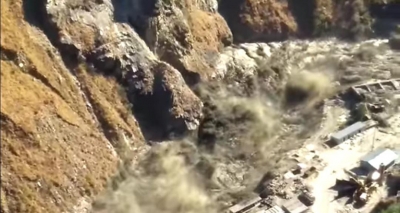'Uttarakhand disaster may be due to water pocket burst'
By IANS | Published: February 7, 2021 05:56 PM2021-02-07T17:56:03+5:302021-02-07T18:05:23+5:30
New Delhi, Feb 7 A massive flood in Uttarakhand's Joshimath area on Sunday is a rare incident of ...

'Uttarakhand disaster may be due to water pocket burst'
New Delhi, Feb 7 A massive flood in Uttarakhand's Joshimath area on Sunday is a rare incident of a glacial burst, and may be "a climate change event", say leading climate scientists.
Satellite and Google Earth images do not show a glacial lake near the region, but there is a possibility that there may be a water pocket, or lake inside the glacier, in the region that may have erupted leading to the disaster, Mohd. Farooq Azam, who is an Assistant Professor at IIT Indore, told .
"We need further analysis, weather reports and data to confirm if this indeed was the case. It's unlikely that this was a cloudburst, since weather reports in Chamoli district show sunny weather till today with no record of precipitation," he said.
"There is no doubt that global warming has resulted in the warming of the region. Climate change driven erratic weather patterns like increased snowfall and rainfall, and warmer winters have led to the melting point of a lot of snow falling. The thermal profile of ice is increasing.... where earlier the temperature of ice ranged from minus six to minus 20 degree Celsius, it is now minus two, making it more susceptible to melting," he said.
Another scientist, Anjal Prakash, who is the Research Director and Adjunct Associate Professor at the Indian School of Business in Hyderabad, said prima facie this looks very much like a climate change event.
"The IPCC's Special Report on Oceans and Cryosphere in a Changing Climate reports that climate change has altered the frequency and magnitude of natural hazards. The scientists reported with medium confidence that in some regions, snow avalanches involving wet snow have increased, while the rain on snow floods have also increased at lower elevations in springs," Prakash told .
"We do not have the data now to give you information on what has caused the avalanche in Chamoli district but what we know, prima facie, is that this looks very much like a climate change event as the glaciers are melting due to global warming."
He noted that the impact of global warming on glacial retreat is well documented. "The recent assessment report called the Hindu Kush Himalayan Monitoring and Assessment Programme
( With inputs from IANS )
Disclaimer: This post has been auto-published from an agency feed without any modifications to the text and has not been reviewed by an editor
Open in app